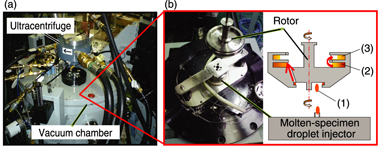 |
The transferring of indium in the rotor
(1) is the initial state of a molten-indium droplet (0.1g-In/shot)
Physical properties of In(2) 113In-enriched move to (3) by overflow Melting point : 156.4 °C
Natural percentage of isotopes :
Specific gravity : 7.9 113In : 4.3%, 115In: 95.7% |
Fig.7-7 (a) Ultracentrifuge (b) Unit developed for separating isotopes in solids or liquids (rotor and molten-specimen droplet injector)
Table 7-1 Percentage of 113In in pure indium before and after centrifugation

Under a strong centrifugal acceleration field of around several hundred thousand g(g= 9.80665 m/s2), in the case of two component alloys, the atoms of heavier and lighter elements move in the direction of centrifugal acceleration and in the opposite direction, respectively. That is to say, sedimentation of atoms results. To study mass dependence in sedimentation of atoms, we developed an ultracentrifuge to generate a centrifugal acceleration up to 1 million g at elevated temperature. Recently (in a collaborative study with Kumamoto University), we have been successful in the sedimentation of constitutional isotopes in a single element, i.e., sedimentation of isotopes, where the sedimentation is dependent only on a small difference in mass among the relevant isotopes. We have confirmed the sedimentation of isotopes in solid or liquid states of pure elements such as Se, In, and Sn.
A centrifugal isotope separation process for solids or liquids had not yet been proposed, although a process in the gaseous state (gas centrifugation) has already been put to practical use to enrich stable isotopes and uranium isotopes. We have devised a technique to show that the sedimentation of isotopes should be the principal phenomenon to realize the other two processes. First, we developed a rotor having 2 grooves for the multi-stage centrifugal isotope separation (in a collaborative study with Maruwa Electric Inc., supported by JAEA’s Reimei Research). Indium was chosen for the isotope separation experiment for the reason that natural indium consists of only two isotopes, and a relatively simple procedure was expected for verification of mass dependent isotope fractionation.
Fig.7-7 (b) shows the rotor we developed and a molten-specimen droplet injector for intermittent specimen feeding, and Table 7-1 shows the percentages of 113In in pure indium before and after centrifugation. The time interval for specimen feeding in the case of a solid was set about 10 times longer than that of a liquid state, to take into consideration the approximate difference in time required to reach a steady state of isotope fractionation in the separation groove, which was attributed to the difference in the diffusion coefficients between the two states. Although there was a difference in the specimen feeding time interval, almost the same separation ratios were obtained in the case of both a solid and a liquid at the same magnitude of acceleration. This indicates that the sedimentation of isotopes occurs according to the same principle in the case of both solids and liquids.
With this development, it has become clear that the sedimentation of isotopes can be used as the principal phenomenon to realize a centrifugal isotope separation process in solids or liquids.